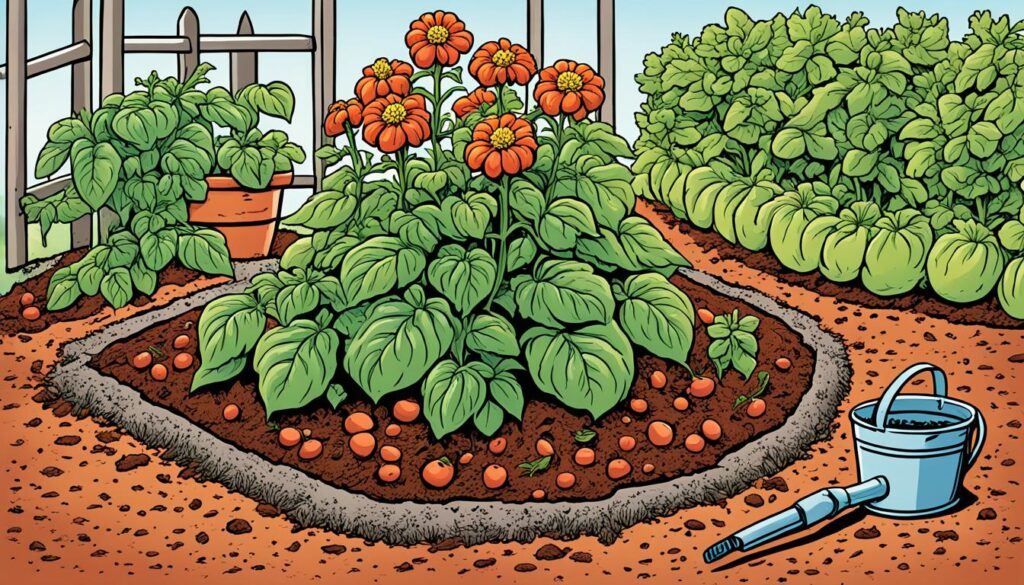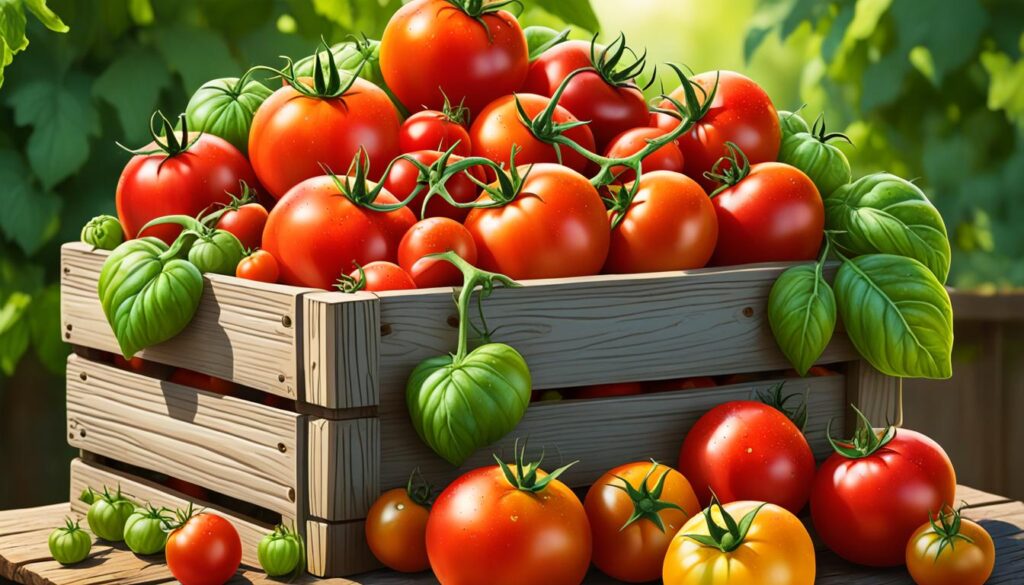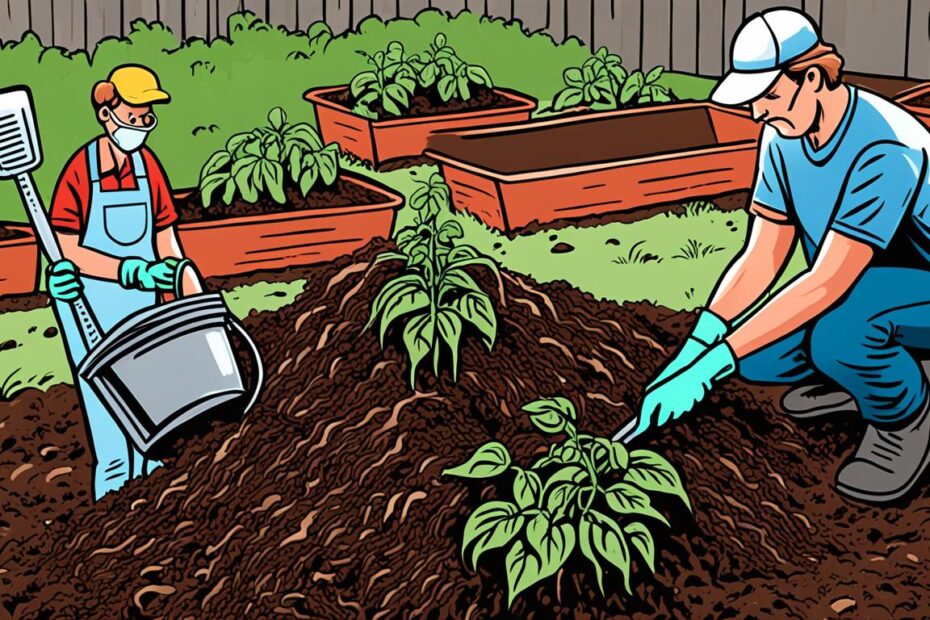Are your tomato plants falling victim to the dreaded tomato blight? Do you find yourself losing your harvest year after year? It’s time to take action and discover the best practices for tomato blight soil treatment.
Tomato blight is a fungal infection that can devastate your tomato plants and wipe out your entire harvest. But fear not, there are strategies you can implement to prevent or minimize its impact. From using powdered milk or crushed eggshells in the soil to rotating your plants each year, these best practices can make all the difference.
So, how can you protect your precious tomato plants and ensure a bountiful harvest? Dive into this article to learn the most effective soil treatment techniques for tomato blight and take control of your garden!
Key Takeaways:
- Tomato blight is a fungal infection that can destroy your tomato plants and harvest.
- There is no cure for tomato blight, but soil treatment strategies can help prevent or minimize its impact.
- Best practices for tomato blight soil treatment include using powdered milk or crushed eggshells, watering at the base, and rotating plants.
- Identifying the signs of tomato blight and taking immediate action is crucial for preventing its spread.
- Implementing environmental controls, practicing good plant hygiene, and using resistant tomato varieties can help prevent tomato blight.
Understanding Tomato Blight
Tomato blight, also known as late blight or early blight, is a fungal infection that can have a devastating impact on tomato plants. Late blight (Phytophthora infestans) is the more common type of blight and can spread rapidly, causing the leaves to turn yellow and develop brown spots. On the other hand, early blight (Alternaria solani or Alternaria tomatophila) is characterized by small brown marks on the lower leaves of tomato plants.
Both late blight and early blight have the potential to rot the entire plant if left untreated. Therefore, it is crucial to learn how to identify the signs of tomato blight and take immediate action to prevent its spread.
“Both late blight and early blight have the potential to rot the entire plant if left untreated.”
If you spot any yellowing leaves with brown spots or small brown marks on the lower leaves of your tomato plants, these could be early signs of blight. It’s important to inspect your plants regularly and look for any signs of infection.
Identifying the signs of tomato blight is the first step towards effectively managing the disease and protecting your tomato plants.
By understanding the different types of blight and their symptoms, you can take the necessary measures to prevent the disease from spreading and ensure the health of your tomato plants.
Preventing Tomato Blight
To ensure a healthy tomato harvest, it is important to take proactive measures to prevent tomato blight or minimize its impact. By implementing environmental controls and utilizing resistant tomato varieties, you can significantly reduce the risk of infection.
Environmental Controls
Environmental conditions play a crucial role in the development and spread of tomato blight. By implementing the following environmental controls, you can create an unfavorable environment for the blight-causing fungi:
- Keep the plants dry: Avoid overhead watering, as wet leaves and high humidity can encourage the spread of blight. Instead, water the plants at the base, directly into the soil.
- Provide good ventilation: Proper air circulation helps in drying out the foliage and reduces the chances of blight. Consider spacing the tomato plants adequately and pruning excess foliage.
- Tie up or stake the plants: Supporting the tomato plants with stakes or cages allows better air circulation and reduces contact with the ground, minimizing the risk of soil-borne pathogens.
- Remove lower leaves: Regularly remove the lower leaves that are in contact with the soil, as they are more susceptible to fungal infections.
- Water in the morning: Watering in the morning allows the foliage to dry out during the day, reducing moisture levels and preventing blight development.
Planting and Crop Rotation
Proper planting practices and crop rotation are essential for preventing the buildup of blight in the soil. Consider the following steps:
- Choose a disease-free location: Before planting, ensure that the soil is free from blight or other plant diseases. Avoid planting tomatoes in areas where blight has previously been a problem.
- Practice good plant hygiene: Regularly remove and destroy any diseased plant material to prevent the spread of blight. This includes disposing of infected plant debris and fruit in a responsible manner.
- Rotate crops: Avoid planting tomatoes in the same soil year after year. Rotate tomato plants with other non-solanaceous crops to disrupt the lifecycle of blight-causing pathogens.
Resistant Tomato Varieties
Using tomato varieties that are resistant to blight is an effective way to reduce the risk of infection. These varieties have been specifically bred to possess natural resistance against blight-causing fungi. When selecting tomato varieties for your garden, look for those that are labeled as resistant to blight. Some popular blight-resistant tomato varieties include:
Tommy Toes: A cherry tomato variety with exceptional disease resistance and sweet, flavorful fruits.
Legend: A determinate variety that exhibits excellent resistance to both early and late blight. It produces medium-sized, tasty tomatoes.
Juliet: A prolific indeterminate variety with resistance to various diseases, including blight. It produces clusters of small, plum-shaped fruits that are great for salads and snacking.
Manyel: A blight-resistant hybrid variety with large, succulent fruits and excellent flavor.
By incorporating these resistant varieties into your garden, you can enjoy a more reliable harvest while minimizing the risk of blight.

Tomato Blight Treatment Options
While chemical treatment may not be available for tomato blight, there are effective options for managing this disease. Taking swift action is essential to prevent the spread of blight and protect your tomato plants. Two treatment methods that have shown positive results are using a baking soda solution and removing infected plants.
1. Baking Soda Solution
A baking soda solution can be a valuable tool in your efforts to control tomato blight. The alkaline properties of baking soda create an unfavorable environment for fungal growth. To prepare the solution, mix 1 tablespoon of baking soda with 1 gallon of water. Using a spray bottle, apply the solution to the leaves, stems, and the surrounding soil of your tomato plants. This will help disrupt the growth and spread of blight spores.
2. Removing Infected Plants
As soon as you notice signs of blight on your tomato plants, it is crucial to remove the infected plants immediately. This will prevent the disease from spreading to healthy plants nearby. Carefully dig up the infected plants, ensuring you remove the entire root system. Place the infected plants in a trash bag, seal it tightly, and dispose of it properly. Burning the foliage and fruit of infected plants or composting them can help eliminate the blight spores.
Regularly inspecting your tomato plants for any signs of blight and promptly taking action is key to effective treatment. By investing time and effort in tomato blight treatment, you can increase the chances of a successful harvest.
Summary Table: Tomato Blight Treatment Options
| Treatment Method | Description |
|---|---|
| Baking Soda Solution | Prepare a solution by mixing baking soda with water and spray on the plants to disrupt blight spore growth. |
| Removing Infected Plants | Dig up and dispose of infected plants to prevent the spread of blight to healthy plants. |
Tomato Blight and Harvested Tomatoes
If you have tomatoes that are infected with tomato blight, it is important to distinguish between the affected and unaffected fruits. While tomatoes with obvious signs of blight should not be consumed, ripe tomatoes that do not show signs of infection can still be safely eaten.
It is recommended to harvest any green tomatoes that are not affected by blight and use them for green tomato chutney or other recipes. By cooking the green tomatoes, you can still enjoy their flavor while reducing the risk of consuming infected fruits.
Practicing good plant hygiene is crucial in preventing the further spread of blight. Dispose of infected plants properly to avoid contaminating other plants in your garden. This includes burning or composting the foliage and fruit of infected plants, as composting can help kill off the spores.

Remember, the key is to be vigilant in identifying and separating infected tomatoes from the healthy ones. By doing so, you can still enjoy a bountiful tomato harvest without compromising your health.
Identifying Tomato Blight Symptoms
| Symptom | Description |
|---|---|
| Yellowing leaves | Leaves turning yellow, often starting from the bottom |
| Brown spots | Irregular brown spots appearing on leaves and stems |
| Fruits with dark lesions | Rotten spots on the fruits with a dark, moldy appearance |
| White powdery coating | A fuzzy white mold covering leaves, stems, and fruits |
| Mushy fruits | Fruits becoming soft and mushy, often accompanied by a foul odor |
Refer to the table above to help you identify the symptoms of tomato blight and make informed decisions about which tomatoes to consume.
Blight-Resistant Tomato Varieties
Breeding efforts have resulted in the development of tomato varieties that are resistant to blight. These varieties have been specifically bred to have improved disease resistance and can help reduce the risk of infection.
Some examples of blight-resistant tomato varieties include:
| Variety | Description |
|---|---|
| Tommy Toes | A small cherry tomato variety known for its sweet flavor and high disease resistance. Perfect for salads and snacking. |
| Legend | A determinate variety with excellent blight resistance. Produces medium-sized, meaty tomatoes that are great for slicing and canning. |
| Juliet | A prolific indeterminate variety that bears clusters of sweet, elongated tomatoes. Ideal for fresh eating, roasting, or making sauces. |
| Manyel | A versatile determinate variety that offers exceptional resistance to blight. It produces large, flavorful tomatoes that are perfect for slicing and cooking. |
These blight-resistant tomato varieties not only provide protection against the disease but also deliver robust flavors and high yields. Whether you’re an experienced gardener or just starting, incorporating these varieties into your garden can help minimize the impact of tomato blight on your harvest.
Conclusion
Tomato blight is a serious disease that can have devastating effects on your tomato plants. However, by implementing best practices for tomato blight soil treatment, you can prevent or minimize its impact and increase the chances of a healthier and more successful harvest.
One of the key factors in managing tomato blight is environmental control. Keep your plants dry and well-ventilated, as moisture promotes the growth and spread of the disease. Water your plants at the base to avoid wetting the leaves, and consider using methods such as powdered milk or crushed eggshells in the soil, or spraying compost water on the plants to create a less favorable environment for blight to thrive.
Choosing resistant tomato varieties is another effective strategy. These varieties have been specifically bred to have better disease resistance, including resistance to tomato blight. Varieties such as Tommy Toes, Legend, Juliet, and Manyel offer both great flavors and high yields, making them ideal choices for gardeners looking to minimize the impact of blight on their crops.
Regular monitoring and quick action are crucial in managing tomato blight effectively. Remove any infected plants immediately to prevent the spread of the disease, and practice good plant hygiene by properly disposing of the infected plants. By following these best practices, you can significantly reduce the risk of tomato blight and increase the chances of a successful and bountiful harvest.
FAQ
What is tomato blight?
Tomato blight is a fungal infection that affects tomato plants and can lead to the loss of an entire harvest. It is caused by the pathogens Phytophthora infestans (late blight) or Alternaria solani/Alternaria tomatophila (early blight).
How can I prevent tomato blight in my garden?
There are several best practices you can follow to prevent tomato blight:
– Keep the plants dry and provide good ventilation.
– Water the plants at the base to avoid wetting the leaves.
– Tie up or stake the plants to improve air circulation.
– Remove lower leaves to minimize the risk of infection.
– Rotate your tomato plants to different locations each year to prevent the buildup of blight in the soil.
– Plant tomatoes in a disease-free location and practice good plant hygiene.
– Consider using tomato varieties that are resistant to blight.
Are there any treatments for tomato blight?
While there is no cure for tomato blight, there are some treatment options available. You can use a baking soda solution to spray on the plants, which can help prevent the spread of spores. It is also important to remove any infected plants immediately to prevent the spread of blight to other plants. Infected plant foliage and fruit should be burned or composted to help kill off the spores.
Can I eat tomatoes that are affected by blight?
Tomatoes with obvious signs of blight should not be consumed. However, ripe tomatoes that do not show signs of infection can still be safely eaten. It is recommended to harvest any green tomatoes that are not affected by blight and use them for green tomato chutney or other recipes.
Are there any tomato varieties that are resistant to blight?
Yes, breeding efforts have resulted in the development of tomato varieties that are resistant to blight. Some examples of blight-resistant tomato varieties include Tommy Toes, Legend, Juliet, and Manyel. These varieties offer robust flavors and high yields, making them a great choice for gardeners looking to minimize the impact of tomato blight on their harvest.
